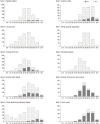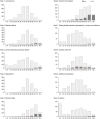The Non-Communicable Disease Burden in Korea: Findings from the 2012 Korean Burden of Disease Study
- PMID: 27775253
- PMCID: PMC5081297
- DOI: 10.3346/jkms.2016.31.S2.S158
The Non-Communicable Disease Burden in Korea: Findings from the 2012 Korean Burden of Disease Study
Abstract
In recognition of Korea's rising burden of non-communicable diseases (NCDs), we investigated the nation's NCD status and extracted detailed information from the 2012 Korean Burden of Disease study. Consistent with that study, we used disability-adjusted life year (DALY) as a metric. Using national data sources and disability weights specific to the Korean population, we analyzed 116 disaggregated NCDs from the study's four-level disease and injury hierarchy for both sexes and nine age groups. Per 100,000 population, 21,019 DALYs were lost to 116 NCDs. Of those, 13.97% were due to premature death (death prior to the standard life expectancy for a subject's age) and 86.03% to non-fatal health outcomes. Based on traditional statistics, the main causes of health loss were mortality of neoplasms; cardiovascular and circulatory diseases; diabetes, urogenital, blood, and endocrine diseases; and chronic respiratory diseases. When combined with analyses of premature death and non-fatal outcomes, however, a substantially different view emerged: the main causes of health loss were diabetes mellitus, low back pain, chronic obstructive pulmonary disease, ischemic heart disease, ischemic stroke, cirrhosis of the liver, osteoarthritis, asthma, gastritis and duodenitis, and periodontal disease (in that order), collectively causing 49.20% of DALYs. Thus, burden of disease data using DALYs rather than traditional statistics brings a new perspective to characterization of the population's health that provides practical information useful for developing and targeting national NCD control programs to better meet national needs.
Keywords: Burden of Disease; DALY; Disability-adjusted Life Years; Korea; Non-communicable Diseases.
Conflict of interest statement
The authors have no potential conflicts of interest to disclose.
Figures





References
-
- Korea Centers for Disease Control and Prevention. Factbook: Non-communicable Diseases 2015. Cheongju: Korea Centers for Disease Control and Prevention; 2015.
-
- Statistics Korea. Trends in life expectancy and healthy life expectancy [Internet] [accessed on 3 January 2015]. Available at http://www.index.go.kr/potal/main/EachDtlPageDetail.do?idx_cd=2758.
-
- Ko SJ, Jung YH. Health-adjusted life expectancy in Korea. Issue Focus. 2014;247:1–8.
-
- Murray CJ, Salomon JA, Mathers CD, Lopez AD. Summary Measures of Population Health: Concepts, Ethics, Measurement and Applications. Geneva: World Health Organization; 2002.
-
- Van der Maas PJ. Applications of summary measures of population health. In: Murray CJ, Salomon JA, Mathers CD, Lopez AD, editors. Summary Measures of Population Health: Concepts, Ethics, Measurement and Applications. Geneva: World Health Organization; 2002. pp. 53–60.
MeSH terms
LinkOut - more resources
Full Text Sources
Other Literature Sources
Medical

